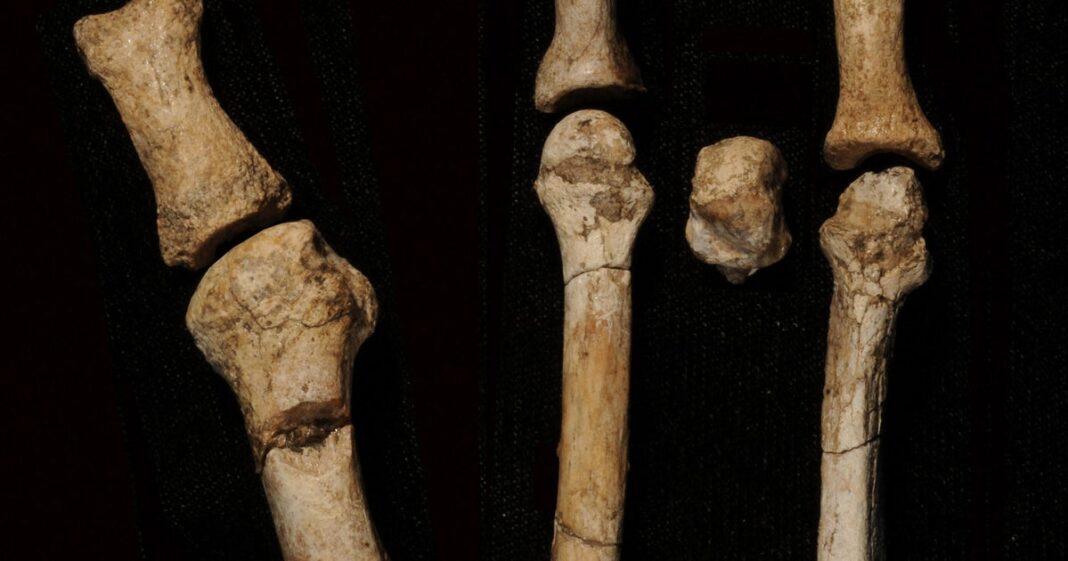Newly discovered fossils prove that a mysterious foot found in Ethiopia belongs to a little-known, recently named ancient human relative who lived alongside the species of the famous Lucy, scientists said Wednesday.
The discovery is the latest twist in the tale of human evolution and could even cast some doubt on the status of Lucy’s species, Australopithecus afarensis, as the direct ancestor of Homo sapiens.
Until the foot was discovered in Burtele in northeastern Ethiopia in 2009, Lucy’s species was thought to be the only human relative living in the area more than three million years ago.
But the appendage clearly does not belong to Lucy’s species because it has an opposable toe — similar to a thumb — allowing its owner to grab onto tree branches like apes.
The team of scientists who found the mystery foot went on to name a new species, Australopithecus deyiremeda, in 2015 based on some roughly 3.4-million-year-old jaw bones found in Burtele.
The announcement was met with some skepticism in scientific circles. Due to the scarcity of fossils, attempts to add a new branch to the human family tree usually provoke fierce debate.
The team was also unable to say that the foot bones — dubbed the Burtele foot — belonged to their new species.
Now, in a study published Tuesday called “Mystery owner of African hominin foot identified,” the scientists announced that new fossils including a jawbone with 12 teeth found at the site show that the foot was that of A. deyiremeda.
“We have no doubt about the Burtele foot belonging to the same species as these teeth and the jaw,” lead study author, Yohannes Haile-Selassie of Arizona State University, told AFP.
Yohannes HAILE-SELASSIE / Institute of Human Origins at Arizona State University /AFP via Getty Images
The research also revealed more details about this species, offering further clues about who could have been the true ancestor of us Homo sapiens.
“Co-existence is deep in our ancestry”
A CT scan of the teeth suggested that A. deyiremeda was more primitive than its cousin Lucy, the study said.
Isotope analysis of the teeth meanwhile showed that its diet consisted mainly of leaves, fruit and nuts of trees.
The grasping big toe also suggested this human relative spent more time in the trees. Big toes played an important role in human evolution, allowing our ancestors to leave the trees behind and walk on two legs.
A lingering question about A. deyiremeda was how it could have co-existed with Lucy’s species at the same place and time, Haile-Selassie said.
The new research suggests that the former spent its time in the forest, more likely eating from trees, while the latter spent more time on the ground, a difference that allowed them to live together.
It also demonstrates that “co-existence is deep in our ancestry”, Haile-Selassie emphasised.
Earlier this year, in the same region where was Lucy was discovered, archaeologists found 3,000-million-year-old knives that are believed to be some of the first tools ever used on Earth. Rick Potts, the director of the Smithsonian’s human origins program and the leader of research on the peninsula, told CBS News that discovery can help frame humans’ existence on the planet.
“We are the last biped standing, as I call it,” Potts said. “All of those other ways of life became extinct. And so that gives us a lot to think about, and it draws attention to the fragility of life, even in our own journey through time.”
New technologies have made the sites easier to date, and new discoveries across eastern Africa have refined researchers’ understanding of human roots. Researchers knew that modern homo sapiens emerged in Africa about 300,000 years ago, but it wasn’t until recently that they understood that their hominin ancestors began walking on two legs at least 6 million years ago.
Search for the identity of our true ancestor
John McNabb, a paleolithic archaeologist at the UK’s University of Southampton not involved in the study, praised the new research.
“There will always be sceptics, but I think these new finds, and their validation of older ones, will help many researchers to be more accepting of A. deyiremeda,” he told AFP.
It also “adds a new player into the mix” in the search for the identity of our true ancestor, McNabb added.
Because A. deyiremeda was more primitive and had a less human-like foot than Lucy, it is unlikely to dethrone her as the prime suspect in this search, both scientists agreed.
But the discovery “opens this possibility that we might still find more species within that time period because it looks like the Australopiths were experimenting with bipedality,” or walking on two legs, Haile-Selassie said.
MICHAL CIZEK/AFP via Getty Images
“Could there be another species which could be a better candidate to be the ancestor of the genus Homo?” he asked.
“We don’t know — it depends on what we find.”




